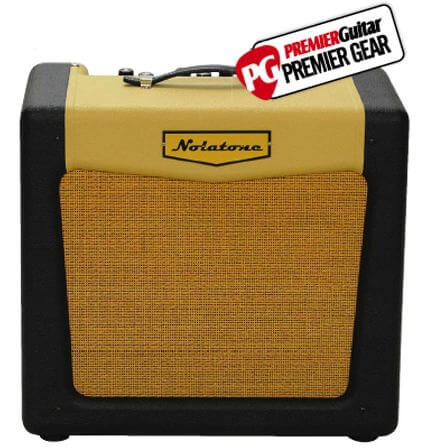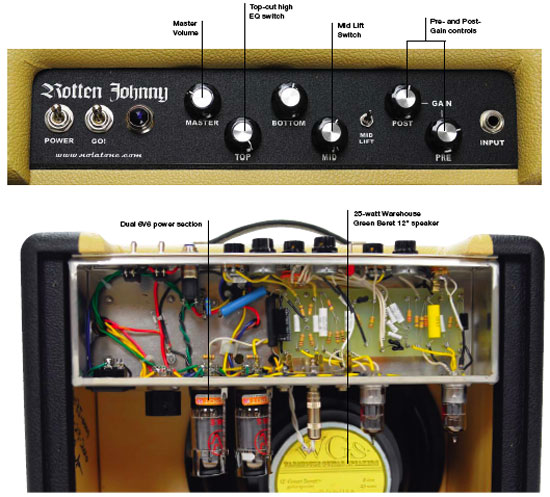
The en vogue status of low-wattage combo amps remains a boon for any guitarist on the lookout for a compact amp. Just about every major amp company and most boutique shops are offering at least one model in the 12- to 18-watt range and that’s a great thing. What’s not to like about an amp that you can push hard without blowing out the windows or that you can throw in the front seat of your car for a gig?
Nolatone Ampworks — and the work of Paul Sanders — are already standouts in this fast-growing amp category. Hand built by Paul in Raleigh, North Carolina, using only the highest quality parts, Nolatone models like the June Bug and Chimey Limey have already made a mark for their interpretations of Fender Tweed and Vox tones. They might also be some of the sharpest looking amplifiers available today. And on both the sound and visual front, Nolatone’s 15-watt Rotten Johnny is every bit as spectacular a performer as its cousins in the Nolatone line.
The Dirt
Weighing in at a very reasonable 28 pounds with dimensions similar to a Fender Blues Junior (18″ x 16″ x 10.5″), the Rotten Johnny is an open-back 1×12 combo constructed of solid dovetail-jointed pine. Our review Rotten Johnny came in covered in two-tone brown and crème vinyl with basket weave grille cloth, and sported the signature Nolatone “V” panel TV front design. The 12″ speaker is a 25-watt Warehouse Green Beret, which is designed to sound like a broken-in Celestion greenback. The circuit is built around two JJ 6V6 power tubes (you can also request EL84s) and two 12AX7s. Everything under the hood is top-notch, including custom Mercury Magnetics iron, 1-watt carbon film resistors, F&T filter caps, Switchcraft jacks, and Carling switches laid out on a hand-wired turret board.
Unlike many lower-wattage amps, the Rotten Johnny offers far more control options than a single volume and tone control. The top panel consists of a unique 3-band EQ (Bottom, Mid, Top), as well as Pre- and Post-Gain controls and a Master volume. A Mid Lift switch (which can also be activated by a footswitch) effectively works as a boost for solos. Power and standby switches reside next to a red jewel power indicator.
The EQ section is a little more flexible than what you’ll find on a production-line low-watt amp. The Bottom control is a 6-way switch that progressively rolls off bass. The independent Mid control is not part of a typical tone stack configuration — dialing it down extends the highs and lows to create a very Fender-like mid-scooped tone. The High control, meanwhile, is a Vox-style top-boost reverse-wired to enable players to move from chiming to much darker tones by backing off the control. Borrowing a move from Nolatone’s June Bug design, the Pre- and Post-Gain controls work in tandem to control the amount of gain to the second stage and phase inverter respectively.
Rockin’ the Filament
With a Godin Icon Type 2 with Duncan P-Rails in hand, I got right down to the business of exploring the wide-open voice of the Rotten Johnny. With the Godin set to the humbucker position, I cranked the Master to full, set the Post Gain to around noon and brought up the Pre Gain until I got a rich, full distortion. The sound was raw and thick, but I wanted a little more clarity, so I dialed back the Bottom knob by a few clicks, scaling down the thickness a touch, but opening up the sound considerably. The combination was reminiscent of Frampton’s Rockin’ the Fillmore-era Humble Pie tone — a pretty huge sound for a 15-watt 1×12 combo. And if I closed my eyes, I’d swear I was listening to a full stack in miniature. For years, I’ve tried to harness 100- and 50-watt amps with attenuators and master volumes and never been totally successful. Needless to say, I was stunned when two 6V6s pushing a single 12″ gave me what I’ve been looking for—and then some.

Wielding my ’74 Les Paul Custom and with the Mid control set to the non-lift position, I was able to dial in AC/DC rhythm tones with just the right amount of kerrang and chime to create the illusion of a blaring baby JTM45. And setting the Pre Gain to noon and ramping up the Post Gain added gobs of thick, juicy crunch with just enough bark to cut through a mix. This is where the Top control really shines — pulling the Top back just a touch takes some of the edge off without muddying the tone. It’s voiced for just the right amount of sheen and clarity without ever being brittle or ice-picky. The top-cut configuration also makes the effectiveness of the Mid control’s sweep range very apparent — enabling boosts in presence that aren’t too brittle.
The Mid control is almost like another gain knob, delivering more distortion and dimension the more you crank it. And with the Mid Lift engaged Rotten Johnny turns into a roaring fire-breather with more gain than most of us would ever need. I’ve rarely heard a 6V6 amp sound this way — often assuming some of the tonal qualities of EL34s and EL84s. Though it only takes cutting the Mid and backing off the Pre Gain to get back to more blackface-like territory that was a perfect match for my Strat.
For a 15-watt amp, the Rotten Johnny doesn’t lack headroom. Because there is so much control via Pre and Post gain over how hard you hit the tubes, I found myself digging deep into the wealth of Strat-friendly clean sounds you can get with less aggressive use of those controls. It was easy to conjure thick and chewy cleans with just a hint of grind by pushing the Post Gain and leaving the Master wide open. Even with the Mid Lift engaged I could still hit the guitar hard without harsh sounding breakup. And I was always able to shape the thickness with the Bottom switch, which I used extensively to match individual guitars to the amp.
The Verdict
It’s been a long time since I’ve been so excited about a new amp. The Rotten Johnny has a huge range of brilliant tones in a compact design that, at $1399, doesn’t break the bank. For bedroom or studio musicians, it’s a dream because you can coax out cranked stack sounds without knocking down walls and get the most beautiful cleans with the twist of a few knobs. The construction is top notch and the styling is classy and cool. For an amp that’s roughly the same size as a 1×12 cab and weighs less than 30 pounds, it has the sonic personality of something much larger. I only wish this little guy was around when I first started playing guitar. Thankfully, I’ll have the chance to make up for lost time — my own Rotten Johnny is on the way and I can’t wait to cut loose.
Buy if…
you want everything from Brit aggressiveness to blackface tones in a compact package at a fair price.
Skip if…
you actually need the power to blow down barns.
Rating…
![]()
![]()
![]()
![]()
![]()
Source: https://mercurymagnetics.com/pages/news/PremierGuitar/PremierG-30.htm